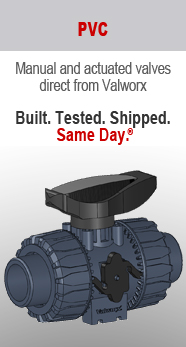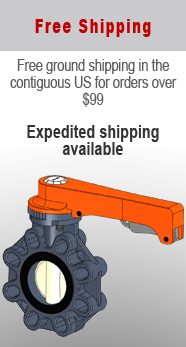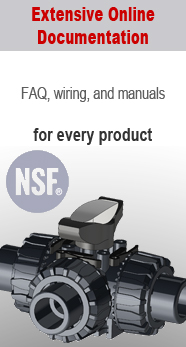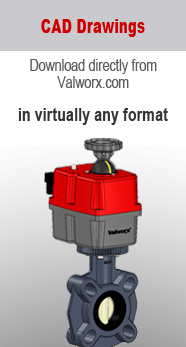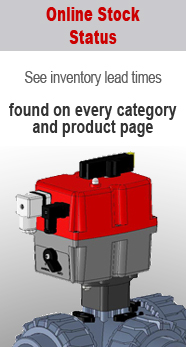PVC
Learn About PVC Ball Valves
PVC (polyvinyl chloride) valves offer several advantages over metal valves, but like all engineering challenges there are also tradeoffs.
PVC is one of the most widely produced plastics in the world. It was adopted for widespread use in plumbing applications in the 1970's. PVC is a thermoformed plastic, meaning it will deform or even melt at high temperatures and can be repurposed with essentially no degradation in the original properties. PVC is therefore amenable to recycling. This is in contrast to thermoset plastics which undergo a complicated chemical reaction when cooling. Once cooled the plastic cannot be heated and reformed as the chemical composition has changed.
There are two basic types of PVC. Rigid PVC is commonly referred to as unplasticized PVC, or uPVC. This material has excellent hardness and strength properties, and is used for pipes, valves and fittings. Flexible PVC (fPVC) has been modified by the addition of plasticizers. fPVC is used as insulation for wire cables, inflatables, and as flexible vinyl seat coverings in cars, among other uses. This discussion will focus on uPVC.
A subset of uPCV is CPVC, which is created by additional chlorination of uPVC. CPVC has better strength at higher temperature and is often used for hot water plumbing.
Compared to stainless and brass valves, a PVC valve has superior corrosion resistance and in general is lower cost. PVC has a smooth bore which reduces pressure loss. PVC is suitable for potable water and many PVC valve manufacturers certify their valves for potable water use. A common certification standard is NSF 61. All Valworx PVC ball and butterfly valves are certified to NSF 61 for potable drinking water.
PVC experiences a slight degradation with extensive UV ray exposure as a thin outer layer (0.001- 0.002") is converted to polyene formations. PVC will lose its gloss over time and start "chalking", a phenomenon known as "PVC sunburn". This generally does not compromise the material performance as it is only a thin layer that is affected.
While it has many advantages, PVC also has drawbacks. Its tensile strength is high for a plastic, but much lower than brass or stainless steel. Industrial PVC ball valves are rated to ~230psi, in contrast to brass (~600psi) or stainless (~1000+ psi). As a thermoform plastic, PVC degrades with temperature, with a typical maximum of ~140°F, and it becomes brittle at temperatures around freezing. Both brass and stainless have much broader temperature ranges.
Also, PVC valves should never be used for compressed gas applications, as they will shatter into dangerous shards if ruptured.
PVC is used to make several common types of valves such as ball valves, butterfly valves and diaphragm valves. They are commonly used as shutoff valves, control valves and check valves.



Components for a PVC ball valve are the same as its metal counterpart. An outer shell is used to house a bored spherical PVC ball. Fluid control is accomplished by rotating the ball via a stem which is connected to handle or actuator. Sealing is accomplished by stem and valve seat seals.
3-way PVC ball valves, like brass and stainless 3-way valves, are available in T-port and L-port configurations and can be used as mixing, selector or diverter valves.


Higher quality PVC ball valves will be full port design. Full port means the bore of the PVC ball is the same diameter as the pipe interior. (Standard port valves have a reduced bore.) Full port valves offer higher flow rates through the same pipe diameter. All Valworx PVC ball valves are full port.
Similarly, PVC butterfly valves have the same components (different materials) as metal butterfly valves. An outer shell houses a disc which is connected to a stem. Fluid control is accomplished by rotating the disc via a handle or actuator, and sealing is accomplished by the disc compressing against an elastomeric disc seal. A series of O-rings are used for stem sealing.
PVC ball valves can be quickly and easily installed with threaded or solvent welded connections. One common method involves placing a union nut over the pipe. A flange end is then solvent welded or threaded to the pipe end. The union nut is threaded onto the valve. This allows the valve body to be completely removed and the ball and/or seals replaced or repaired. This type of connection is called a "true union" connection.
Valworx PVC ball valves come with a set of both welded and threaded flange ends. Higher quality PVC ball valves also feature mechanical stops to prevent the union nut from backing off.

Butterfly valves are commonly available with two types of connections. Lug-style butterfly valves are connected by bolts threaded directly into holes on the valve body. However, since the shear strength of PVC is significantly less than the tensile strength of the connecting bolts, threaded metal inserts are often incorporated in the valve body to increase the bearing surface and thus pull-out strength of the lug. Lugged butterfly valves are suitable for end of line applications.
Wafer-style butterfly valves are connected by bolts passing through the valve body flange and bolting to a corresponding pipe flange.
PVC ball and butterfly valves are widely used in potable water and wastewater applications. Their superior corrosion resistance makes them suitable for caustic applications where metal valves would quickly degrade.
However, the temperature range for PVC valves is significantly narrower and pressure ratings lower than comparable brass and stainless valves. In addition, PVC valves should only be used for liquids.




